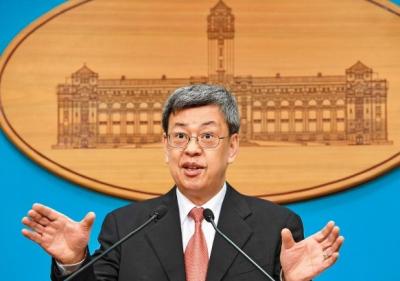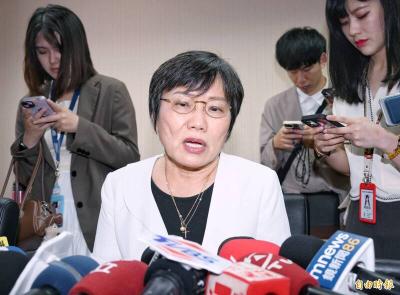An exhibition commemorating pro-democracy movements in Taiwan following the 228 Incident opened in the National 228 Memorial Museum yesterday, with campaigners calling for holding those responsible for the massacre to account and disclosing documents related to the Incident to achieve transitional justice.
The exhibition also commemorates the 30th anniversary of the nation’s first campaign to achieve transitional justice, launched in 1987 by late democracy pioneer Deng Nan-jung (鄭南榕) asking the then-Chinese Nationalist Party (KMT) government to apologize for the massacre and pay compensation to victims, as well as reveal the facts about the Incident and make Feb. 28 a national holiday to commemorate the massacre.
The exhibition features a reconstruction of Deng’s office, a replica of the nation’s first monument dedicated to the Incident, banners and props used by pro-democracy activists, books banned by the former KMT regime, and poems and art inspired by the Incident.

Photo: Chang Chia-ming, Taipei Times
The Incident refers to the crackdown launched by the then-KMT regime against civilian demonstrations following an incident in Taipei on Feb. 27, 1947. The event also marked the beginning of the White Terror era, which saw thousands of Taiwanese arrested, imprisoned and executed.
Deng’s wife, Yeh Chu-lan (葉菊蘭), said the KMT regime killed almost all of the Taiwanese elite during the Incident and the persecutions that followed, an atrocity that silenced Taiwanese for 40 years with people being afraid to talk about the massacre and politics.
Preceded by the “519 Green Movement” in 1986, also initiated by Deng to seek the lifting of martial law, the 228 campaign relieved Taiwanese from the fear of recounting the history of the Incident and motivated them to seek justice, she said.
Although redresses have been made to victims of the Incident, people responsible for the massacre have not been held to account and there might be victims still unnamed in the government’s list, Yeh said.
“Documents written by Chiang Kai-shek (蔣介石) showed that he authorized the executions [of victims of the 228 Incident], but has Chiang been punished by history?” Yeh asked. “There is no transitional justice without perpetrators being punished and the truth being revealed.”
The government needs to disclose all data concerning the massacre and political persecutions to right the wrongs, she added.
While the Democratic Progressive Party (DPP) was established in 1986, few members were involved in Deng’s campaigns, Yeh said, adding that pro-democracy movements at the time were mostly led by regular people, who had to face police violence and persecution.
“The exhibition does not commemorate my late husband, but those people,” she added.
Yeh said she is confident in President Tsai Ing-wen’s (蔡英文) plan to finalize a report on the Incident in three years, although a draft transitional justice bill waits to pass the Legislative Yuan.

Taiwan would welcome the return of Honduras as a diplomatic ally if its next president decides to make such a move, Minister of Foreign Affairs Lin Chia-lung (林佳龍) said yesterday. “Of course, we would welcome Honduras if they want to restore diplomatic ties with Taiwan after their elections,” Lin said at a meeting of the legislature’s Foreign Affairs and National Defense Committee, when asked to comment on statements made by two of the three Honduran presidential candidates during the presidential campaign in the Central American country. Taiwan is paying close attention to the region as a whole in the wake of a

President William Lai (賴清德) has appointed former vice president Chen Chien-jen (陳建仁) to attend the late Pope Francis’ funeral at the Vatican City on Saturday on his behalf, the Ministry of Foreign Affairs said today. The Holy See announced Francis’ funeral would take place on Saturday at 10am in St Peter’s Square. The ministry expressed condolences over Francis’ passing and said that Chen would represent Taiwan at the funeral and offer condolences in person. Taiwan and the Vatican have a long-standing and close diplomatic relationship, the ministry said. Both sides agreed to have Chen represent Taiwan at the funeral, given his Catholic identity and

Chinese Nationalist Party (KMT) Chairman Eric Chu (朱立倫), spokeswoman Yang Chih-yu (楊智伃) and Legislator Hsieh Lung-chieh (謝龍介) would be summoned by police for questioning for leading an illegal assembly on Thursday evening last week, Minister of the Interior Liu Shyh-fang (劉世芳) said today. The three KMT officials led an assembly outside the Taipei City Prosecutors’ Office, a restricted area where public assembly is not allowed, protesting the questioning of several KMT staff and searches of KMT headquarters and offices in a recall petition forgery case. Chu, Yang and Hsieh are all suspected of contravening the Assembly and Parade Act (集會遊行法) by holding

Lawmakers from the Democratic Progressive Party (DPP) yesterday established a friendship group with their counterparts in Ukraine to promote parliamentary exchanges between the two countries. A ceremony in Taipei for the Taiwan-Ukraine Parliamentary Friendship Association, initiated by DPP Legislator Chen Kuan-ting (陳冠廷), was attended by lawmakers and officials, including Deputy Minister of Foreign Affairs Francois Wu (吳志中) and European Economic and Trade Office in Taiwan Director Lutz Gullner. The increasingly dire situation in Ukraine is a global concern, and Taiwan cannot turn its back when the latter is in need of help, as the two countries share many common values and interests,